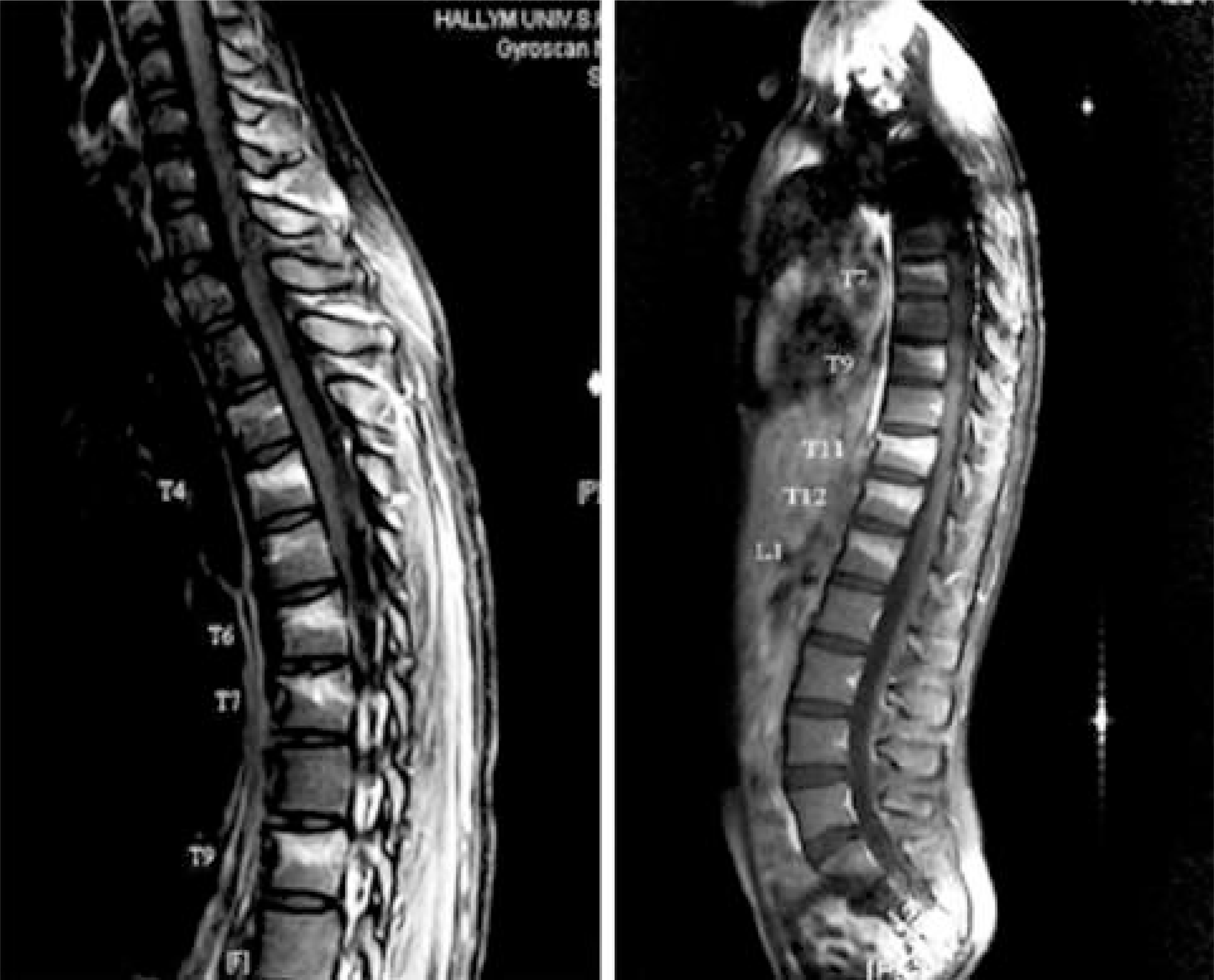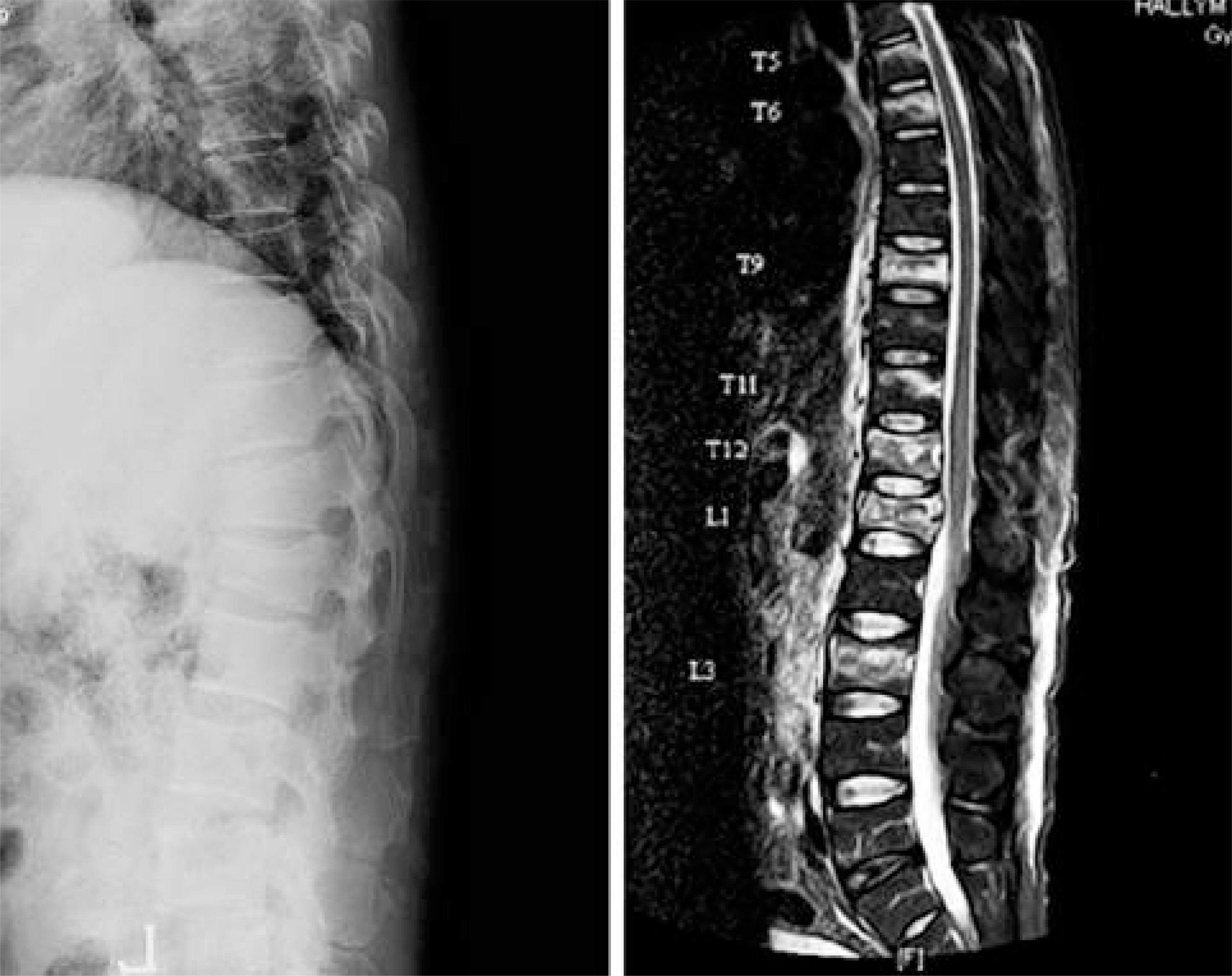Abstract
Objectives
To analyze the mode of injury, associated lesions, time of injury, and the checking times of MRI/CT and Bone scans in multiple spine fractures
Summary of Literature Review
CT was predominantly used to discover and identify the fracture levels of the spine. However, fracture level identification in the entire spine was limited. CT, MRI and Bone scans were used for diagnosing multiple spine fractures.
Materials and Methods
Between 1999 and 2004, 12 patients who had more than level 3 spine fractures were studied. The mode of injury, associated lesions, time of injury, and checking times of MRI/CT and Bone scans were analyzed.
Results
The causes of the spinal injuries were from a fall from height, from traffic accidents and from multi- complex forced trauma in 7, 4 and 1cases, respectively. Most cases had no severe associated lesions. The accuracy of the plain roentgenograms was 26% and that of CT was 35.3%, and the average checking time was 1.5 days. The accuracy of MRI was 100% and the average checking time was 4.3 days. The accuracy of the bone scans was 100%, and the average checking time was 11.7 days. The fracture patterns consisted of 37, 7, 3 and 3 non- compression (74%), compression (14%), burst (6%) and fracturedislocation types (6%), respectively. The major treatment methods used with these patients were conservative. The treatment methods in 4 cases were with the use posterior instrumentation.
Go to : 
REFERENCES
1). Korres DS, Katsaros A, Pantazopoulos T, Hartofi-lakidis-Garofalidis G. Double or multiple level fractures of the spine. Injury. 1981; 13:147–152.

2). Jorgensen RD, Joseph Jr. J. Multiple noncontiguous spine fractures at four levels in a neurologically intact patient. J Trauma. 1996; 41:750–753.

3). Acaroglu ER, Alanay A. Four-level noncontiguous fracture of the vertebral column: a case report. J Orthop Trauma. 2001; 15(4):294–9.
5). Powell JN, Waddell JP, Tucker WS, Transfeldt EE. Multiple-level noncontiguous spinal fractures. J Trauma. 1989; 28:1146–1151.

6). Kosven AM. On complicated fractures of the spine. Ortop Traumatol Protez. 1965; 26:56–8.
7). Griffith HB, Gleave JRW, Taylor RG. Changing patterns of fractures in the dorsal and lumbar spine. Br Med J. 1966; 1:891–894.
8). Calenoff L, Chessare WJ, Rogers FL, et al. Mu lti ple level spinal injuries: Importance of early recognition. Am J Roentgenol. 1978; 130:665–669.
9). Albert TJ, Levine MJ, An HS, et al. Concomitant noncontiguous thoracolumbar and sacral fractures. Spine. 1993; 18:1285–1291.

11). Henderson LR, Reid CD, Saboe AL. Multiple noncontiguous spine fractures. Spine. 1991; 16:128–131.

12). Korres DS, Boscainos PJ, Papagelopoulos PJ, Psy-charis I, Goudelis G, Nikolopoulos. Multiple level noncontiguous fractures of the spine.Clin Orthop. 2003; 411:95–102.
13). Anderson S, Biros MH, Reardon RF. Delayed diagnosis of thoracolumbar fractures in multiple-trauma patients. Acad Emerg Med. 1996; 3(9):832–9.

14). Shear P, Hugenholts H, Richard Mt, et al. Management of noncontiguous vertebral fractures. J Trauma. 1988; 28:655–9.
15). Vaccaro AR, An HS, Lin S, et al. Noncontiguous injuries of the spine. J Spinal Disord. 1992; 5:320–9.

16). Thomas KC, Lalonde F, O'Neil J, Letts RM. Multiple-level thoracolumbar burst fractures in teenaged patients, J Ped Orthop. 2003; 23(1):119–23.

17). Wittenberg RH, Hargus S, Steffen R, Muhr G, Botel U. Noncontiguous unstable spine fractures. Spine. 2002; 1(27):(3):. 254–7.
Go to : 
 | Fig. 1.T1 weighted sagittal MRI showing that spine of 15 year-old woman is noncontiguous 7 level fractures by traffic accidents. |
Table 1.
Summary of cases




 PDF
PDF ePub
ePub Citation
Citation Print
Print



 XML Download
XML Download